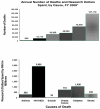Mental health and emergency medicine: a research agenda
- PMID: 20053230
- PMCID: PMC3679662
- DOI: 10.1111/j.1553-2712.2009.00545.x
Mental health and emergency medicine: a research agenda
Abstract
The burden of mental illness is profound and growing. Coupled with large gaps in extant psychiatric services, this mental health burden has often forced emergency departments (EDs) to become the de facto primary and acute care provider of mental health care in the United States. An expanded emergency medical and mental health research agenda is required to meet the need for improved education, screening, surveillance, and ED-initiated interventions for mental health problems. As an increasing fraction of undiagnosed and untreated psychiatric patients passes through the revolving doors of U.S. EDs, the opportunities for improving the art and science of acute mental health care have never been greater. These opportunities span macroepidemiologic surveillance research to intervention studies with individual patients. Feasible screening, intervention, and referral programs for mental health patients presenting to general EDs are needed. Additional research is needed to improve the quality of care, including the attitudes, abilities, interests, and virtues of ED providers. Research that optimizes provider education and training can help academic settings validate psychosocial issues as core components and responsibilities of emergency medicine. Transdisciplinary research with federal partners and investigators in neuropsychiatry and related fields can improve the mechanistic understanding of acute mental health problems. To have lasting impact, however, advances in ED mental health care must be translated into real-world policies and sustainable program enhancements to assure the uptake of best practices for ED screening, treatment, and management of mental disorders and psychosocial problems.
(c) 2009 by the Society for Academic Emergency Medicine.
Figures


Similar articles
-
Trends in mental health and chronic condition visits by children presenting for care at U.S. emergency departments.Public Health Rep. 2007 Jan-Feb;122(1):55-61. doi: 10.1177/003335490712200108. Public Health Rep. 2007. PMID: 17236609 Free PMC article.
-
Alcohol, tobacco, and other drugs: future directions for screening and intervention in the emergency department.Acad Emerg Med. 2009 Nov;16(11):1078-88. doi: 10.1111/j.1553-2712.2009.00552.x. Acad Emerg Med. 2009. PMID: 20053226
-
Improving care planning and coordination for service users with medical co-morbidity transitioning between tertiary medical and primary care services.J Psychiatr Ment Health Nurs. 2017 Aug;24(6):337-347. doi: 10.1111/jpm.12322. Epub 2016 Aug 8. J Psychiatr Ment Health Nurs. 2017. PMID: 27500593
-
Pediatric and adolescent mental health emergencies in the emergency medical services system.Pediatrics. 2011 May;127(5):e1356-66. doi: 10.1542/peds.2011-0522. Epub 2011 Apr 25. Pediatrics. 2011. PMID: 21518712 Review.
-
Mental health services in Army primary care: the need for a collaborative health care agenda.Mil Med. 1994 Mar;159(3):203-9. Mil Med. 1994. PMID: 8041464 Review.
Cited by
-
Pediatric emergency departments' readiness for change toward improving suicide prevention: A mixed-methods study with US leaders.J Am Coll Emerg Physicians Open. 2022 Oct 25;3(5):e12839. doi: 10.1002/emp2.12839. eCollection 2022 Oct. J Am Coll Emerg Physicians Open. 2022. PMID: 36311338 Free PMC article.
-
A preliminary report on resident emergency psychiatry training from a survey of psychiatry chief residents.J Grad Med Educ. 2011 Mar;3(1):21-5. doi: 10.4300/JGME-D-10-00056.1. J Grad Med Educ. 2011. PMID: 22379518 Free PMC article.
-
Lethal means restriction for suicide prevention: beliefs and behaviors of emergency department providers.Depress Anxiety. 2013 Oct;30(10):1013-20. doi: 10.1002/da.22075. Epub 2013 Mar 14. Depress Anxiety. 2013. PMID: 23495002 Free PMC article.
-
The Impact of Coronavirus Disease 2019 on US Emergency Departments.Psychiatr Clin North Am. 2022 Mar;45(1):81-94. doi: 10.1016/j.psc.2021.11.005. Epub 2021 Nov 11. Psychiatr Clin North Am. 2022. PMID: 35219444 Free PMC article. Review.
-
Psychiatric Consultations at an Emergency Department in a Metropolitan University Hospital in Northern Japan.Psychiatry Investig. 2018 Jul;15(7):739-742. doi: 10.30773/pi.2018.04.04. Epub 2018 Jun 28. Psychiatry Investig. 2018. PMID: 29945426 Free PMC article.
References
-
- Kessler RC, McGonagle KA, Zhao S, et al. Lifetime and 12-month prevalence of DSM-III-R psychiatric disorders in the United States. Results from the National Comorbidity Survey. Arch Gen Psychiatry. 1994;51:8–19. - PubMed
-
- Murray C, Lopez A. The Global Burden of Disease: A Comprehensive Assessment of Mortality and Disability From Diseases, Injuries, and Risk Factors in 1990 and Projected to 2020. Vol 1. Harvard University Press; Boston, MA: 1996.
-
- Larkin GL, Claassen CA, Emond JA, Pelletier AJ, Camargo CA., Jr. Trends in U.S. emergency department visits for mental health conditions, 1992 to 2001. Psychiatr Serv. 2005;56:671–7. - PubMed
-
- Kunen S, Niederhauser R, Smith PO, Morris JA, Marx BD. Race disparities in psychiatric rates in emergency departments. J Consult Clin Psychol. 2005;73:116–26. - PubMed
-
- Regier DA, Narrow WE, Rae DS, Manderscheid RW, Locke BZ, Goodwin FK. The de facto US mental and addictive disorders service system. Epidemiologic catchment area prospective 1-year prevalence rates of disorders and services. Arch Gen Psychiatry. 1993;50:85–94. - PubMed
MeSH terms
Grants and funding
LinkOut - more resources
Full Text Sources
Medical
Research Materials

